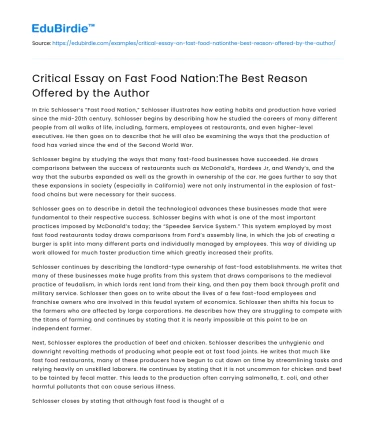In Eric Schlosser’s “Fast Food Nation,” Schlosser illustrates how eating habits and production have varied since the mid-20th century. Schlosser begins by describing how he studied the careers of many different people from all walks of life, including, farmers, employees at restaurants, and even higher-level executives. He then goes on to describe that he will also be examining the ways that the production of food has varied since the end of the Second World War.
Schlosser begins by studying the ways that many fast-food businesses have succeeded. He draws comparisons between the success of restaurants such as McDonald’s, Hardees Jr, and Wendy’s, and the way that the suburbs expanded as well as the growth in ownership of the car. He goes further to say that these expansions in society (especially in California) were not only instrumental in the explosion of fast-food chains but were necessary for their success.
Schlosser goes on to describe in detail the technological advances these businesses made that were fundamental to their respective success. Schlosser begins with what is one of the most important practices imposed by McDonald’s today; the “Speedee Service System.” This system employed by most fast food restaurants today draws comparisons from Ford’s assembly line, in which the job of creating a burger is split into many different parts and individually managed by employees. This way of dividing up work allowed for much faster production time which greatly increased their profits.
Schlosser continues by describing the landlord-type ownership of fast-food establishments. He writes that many of these businesses make huge profits from this system that draws comparisons to the medieval practice of feudalism, in which lords rent land from their king, and then pay them back through profit and military service. Schlosser then goes on to write about the lives of a few fast-food employees and franchise owners who are involved in this feudal system of economics. Schlosser then shifts his focus to the farmers who are affected by large corporations. He describes how they are struggling to compete with the titans of farming and continues by stating that it is nearly impossible at this point to be an independent farmer.
Next, Schlosser explores the production of beef and chicken. Schlosser describes the unhygienic and downright revolting methods of producing what people eat at fast food joints. He writes that much like fast food restaurants, many of these producers have begun to cut down on time by streamlining tasks and relying heavily on unskilled laborers. He continues by stating that it is not uncommon for chicken and beef to be tainted by fecal matter. This leads to the production often carrying salmonella, E. coli, and other harmful pollutants that can cause serious illness.
Schlosser closes by stating that although fast food is thought of as an American institution, it changed the American diet.






 Stuck on your essay?
Stuck on your essay?

